Double-negative feedback loop between long non-coding RNA TUG1 and miR-145 promotes epithelial to mesenchymal transition and radioresistance in human bladder cancer cells

Abstract LncRNAs have a critical role in the regulation of cellular processes such as cancer progression and metastasis. In the present study, we confirmed that TUG1 was overexpressed in bladder cancer tissues and established cell lines. Knockdown of TUG1 inhibited bladder cancer cell metastasis both in vitro and in vivo. Furthermore, we found that TUG1 promoted cancer cell invasion and radioresistance through inducing epithelial-to-mesenchymal transition (EMT). Interestingly, TUG1 decreased the expression of miR-145 and there was a reciprocal repression between TUG1 and miR-145 in an Argonaute2-dependent manner. ZEB2 was identified as a down-stream target of miR-145 and TUG1 exerted its function through the miR-145/ZEB2 axis. In summary, our data indicated that blocking TUG1 function may be an effective anti-cancer therapy.

Downregulation of CCND1 and CDK6 by miR-34a induces cell cycle arrest

miRNAs regulate gene expression by inhibiting translation or by targeting messenger RNA (mRNA) for degradation in a post-transcriptional fashion. In the present study, we show that ectopic expression of miR-34a reduces both mRNA and protein levels of cyclin D1 (CCND1) and cyclin-dependent kinase 6 (CDK6). We also demonstrate that miR-34a targets the 3′-untranslated mRNA region of CCND1 as well as CDK6, which in turn interferes with phosphorylation of retinoblastoma. In addition, we show that overexpression of miR-34a induces a significant G1 cell-cycle arrest in the A549 cell line. Taken together, our data suggest that the effects of miR-34a on G1 cell cycle arrest are through the down-regulation of CCND1 and CDK6, which is associated with other targets of miR-34a either additively or synergistically.

A Loose Relationship: Incomplete H+/Sugar Coupling in the MFS Sugar Transporter GlcP
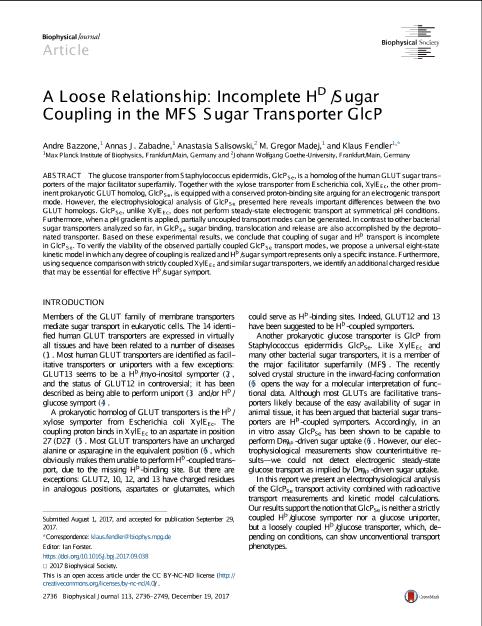
Abstract The glucose transporter from Staphylococcus epidermidis, GlcPSe, is a homolog of the human GLUT sugar transporters of the major facilitator superfamily. Together with the xylose transporter from Escherichia coli, XylEEc, the other prominent prokaryotic GLUT homolog, GlcPSe, is equipped with a conserved proton-binding site arguing for an electrogenic transport mode. However, the electrophysiological analysis of GlcPSe presented here reveals important differences between the two GLUT homologs. GlcPSe, unlike XylEEc, does not perform steady-state electrogenic transport at symmetrical pH conditions. Furthermore, when a pH gradient is applied, partially uncoupled transport modes can be generated. In contrast to other bacterial sugar transporters analyzed so far, in GlcPSe sugar binding, translocation and release are also accomplished by the deprotonated transporter. Based on these experimental results, we conclude that coupling of sugar and H+ transport is incomplete in GlcPSe. To verify the viability of the observed partially coupled GlcPSe transport modes, we propose a universal eight-state kinetic model in which any degree of coupling is realized and H+/sugar symport represents only a specific instance. Furthermore, using sequence comparison with strictly coupled XylEEc and similar sugar transporters, we identify an additional charged residue that may be essential for effective H+/sugar symport.

Promiscuous Binding of Karyopherinβ1 Modulates FG Nucleoporin Barrier Function and Expedites NTF2 Transport Kinetics
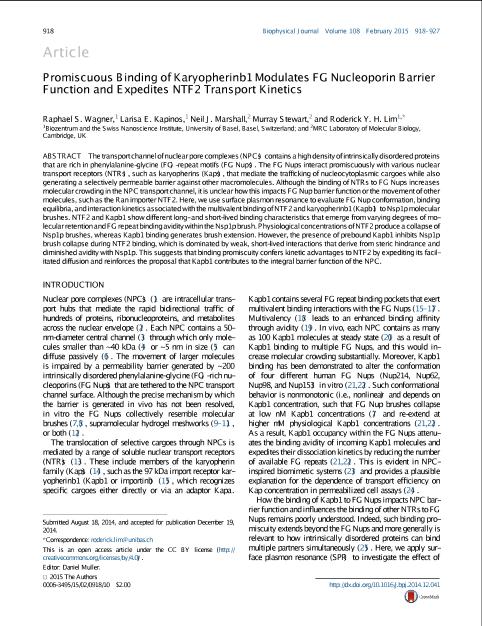
Abstract The transport channel of nuclear pore complexes (NPCs) contains a high density of intrinsically disordered proteins that are rich in phenylalanine-glycine (FG)-repeat motifs (FG Nups). The FG Nups interact promiscuously with various nuclear transport receptors (NTRs), such as karyopherins (Kaps), that mediate the trafficking of nucleocytoplasmic cargoes while also generating a selectively permeable barrier against other macromolecules. Although the binding of NTRs to FG Nups increases molecular crowding in the NPC transport channel, it is unclear how this impacts FG Nup barrier function or the movement of other molecules, such as the Ran importer NTF2. Here, we use surface plasmon resonance to evaluate FG Nup conformation, binding equilibria, and interaction kinetics associated with the multivalent binding of NTF2 and karyopherinβ1 (Kapβ1) to Nsp1p molecular brushes. NTF2 and Kapβ1 show different long- and short-lived binding characteristics that emerge from varying degrees of molecular retention and FG repeat binding avidity within the Nsp1p brush. Physiological concentrations of NTF2 produce a collapse of Nsp1p brushes, whereas Kapβ1 binding generates brush extension. However, the presence of prebound Kapβ1 inhibits Nsp1p brush collapse during NTF2 binding, which is dominated by weak, short-lived interactions that derive from steric hindrance and diminished avidity with Nsp1p. This suggests that binding promiscuity confers kinetic advantages to NTF2 by expediting its facilitated diffusion and reinforces the proposal that Kapβ1 contributes to the integral barrier function of the NPC.

Dynamic Structural Differences between Human and Mouse STING Lead to Differing Sensitivity to DMXAA
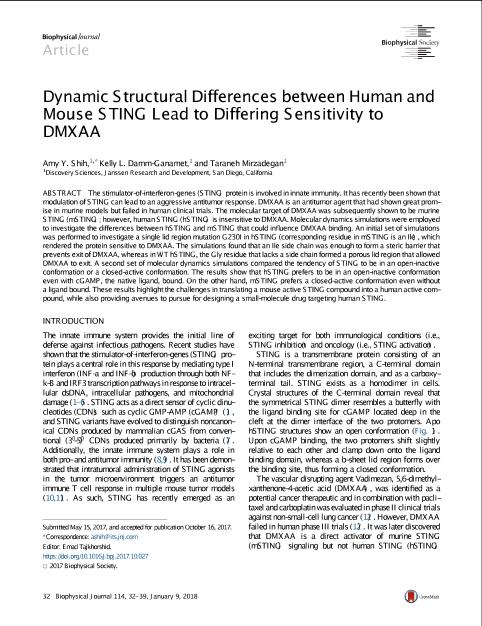
Abstract The stimulator-of-interferon-genes (STING) protein is involved in innate immunity. It has recently been shown that modulation of STING can lead to an aggressive antitumor response. DMXAA is an antitumor agent that had shown great promise in murine models but failed in human clinical trials. The molecular target of DMXAA was subsequently shown to be murine STING (mSTING); however, human STING (hSTING) is insensitive to DMXAA. Molecular dynamics simulations were employed to investigate the differences between hSTING and mSTING that could influence DMXAA binding. An initial set of simulations was performed to investigate a single lid region mutation G230I in hSTING (corresponding residue in mSTING is an Ile), which rendered the protein sensitive to DMXAA. The simulations found that an Ile side chain was enough to form a steric barrier that prevents exit of DMXAA, whereas in WT hSTING, the Gly residue that lacks a side chain formed a porous lid region that allowed DMXAA to exit. A second set of molecular dynamics simulations compared the tendency of STING to be in an open-inactive conformation or a closed-active conformation. The results show that hSTING prefers to be in an open-inactive conformation even with cGAMP, the native ligand, bound. On the other hand, mSTING prefers a closed-active conformation even without a ligand bound. These results highlight the challenges in translating a mouse active STING compound into a human active compound, while also providing avenues to pursue for designing a small-molecule drug targeting human STING.

Structural Influences: Cholesterol, Drug, and Proton Binding to Full-Length Influenza A M2 Protein
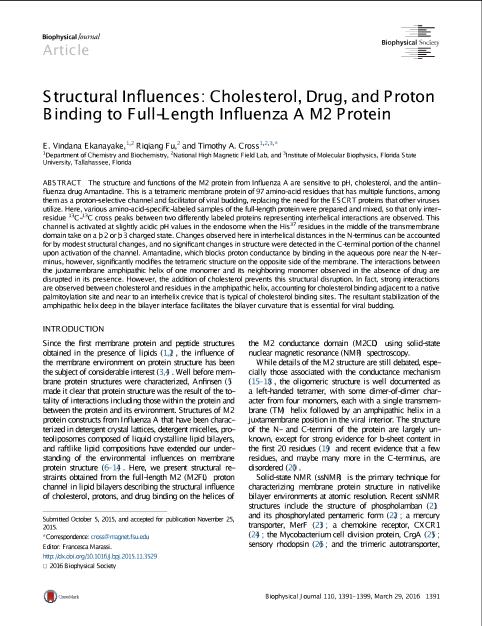
Abstract The structure and functions of the M2 protein from Influenza A are sensitive to pH, cholesterol, and the antiinfluenza drug Amantadine. This is a tetrameric membrane protein of 97 amino-acid residues that has multiple functions, among them as a proton-selective channel and facilitator of viral budding, replacing the need for the ESCRT proteins that other viruses utilize. Here, various amino-acid-specific-labeled samples of the full-length protein were prepared and mixed, so that only interresidue 13C-13C cross peaks between two differently labeled proteins representing interhelical interactions are observed. This channel is activated at slightly acidic pH values in the endosome when the His37 residues in the middle of the transmembrane domain take on a +2 or +3 charged state. Changes observed here in interhelical distances in the N-terminus can be accounted for by modest structural changes, and no significant changes in structure were detected in the C-terminal portion of the channel upon activation of the channel. Amantadine, which blocks proton conductance by binding in the aqueous pore near the N-terminus, however, significantly modifies the tetrameric structure on the opposite side of the membrane. The interactions between the juxtamembrane amphipathic helix of one monomer and its neighboring monomer observed in the absence of drug are disrupted in its presence. However, the addition of cholesterol prevents this structural disruption. In fact, strong interactions are observed between cholesterol and residues in the amphipathic helix, accounting for cholesterol binding adjacent to a native palmitoylation site and near to an interhelix crevice that is typical of cholesterol binding sites. The resultant stabilization of the amphipathic helix deep in the bilayer interface facilitates the bilayer curvature that is essential for viral budding.

Structural Analysis of a Temperature-Induced Transition in a Viral Capsid Probed by HDX-MS
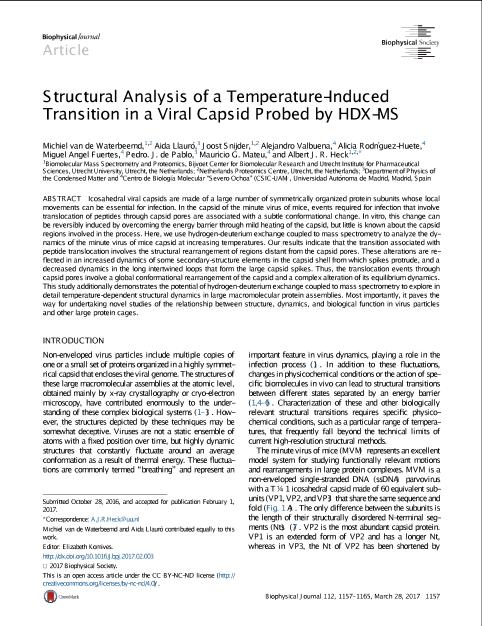
Abstract Icosahedral viral capsids are made of a large number of symmetrically organized protein subunits whose local movements can be essential for infection. In the capsid of the minute virus of mice, events required for infection that involve translocation of peptides through capsid pores are associated with a subtle conformational change. In vitro, this change can be reversibly induced by overcoming the energy barrier through mild heating of the capsid, but little is known about the capsid regions involved in the process. Here, we use hydrogen-deuterium exchange coupled to mass spectrometry to analyze the dynamics of the minute virus of mice capsid at increasing temperatures. Our results indicate that the transition associated with peptide translocation involves the structural rearrangement of regions distant from the capsid pores. These alterations are reflected in an increased dynamics of some secondary-structure elements in the capsid shell from which spikes protrude, and a decreased dynamics in the long intertwined loops that form the large capsid spikes. Thus, the translocation events through capsid pores involve a global conformational rearrangement of the capsid and a complex alteration of its equilibrium dynamics. This study additionally demonstrates the potential of hydrogen-deuterium exchange coupled to mass spectrometry to explore in detail temperature-dependent structural dynamics in large macromolecular protein assemblies. Most importantly, it paves the way for undertaking novel studies of the relationship between structure, dynamics, and biological function in virus particles and other large protein cages.

Interactions of the Anticancer Drug Tamoxifen with Lipid Membranes

Abstract Interactions of the hydrophobic anticancer drug tamoxifen (TAM) with lipid model membranes were studied using calcein-encapsulated vesicle leakage, attenuated total reflection Fourier transform infrared (FTIR) spectroscopy, small-angle neutron scattering (SANS), atomic force microscopy (AFM) based force spectroscopy, and all-atom molecular dynamics (MD) simulations. The addition of TAM enhances membrane permeability, inducing calcein to translocate from the interior to the exterior of lipid vesicles. A large decrease in the FTIR absorption band’s magnitude was observed in the hydrocarbon chain region, suggesting suppressed bond vibrational dynamics. Bilayer thickening was determined from SANS data. Force spectroscopy measurements indicate that the lipid bilayer area compressibility modulus KA is increased by a large amount after the incorporation of TAM. MD simulations show that TAM decreases the lipid area and increases chain order parameters. Moreover, orientational and positional analyses show that TAM exhibits a highly dynamic conformation within the lipid bilayer. Our detailed experimental and computational studies of TAM interacting with model lipid membranes shed new light on membrane modulation by TAM.

Glucosylceramide Reorganizes Cholesterol-Containing Domains in a Fluid Phospholipid Membrane
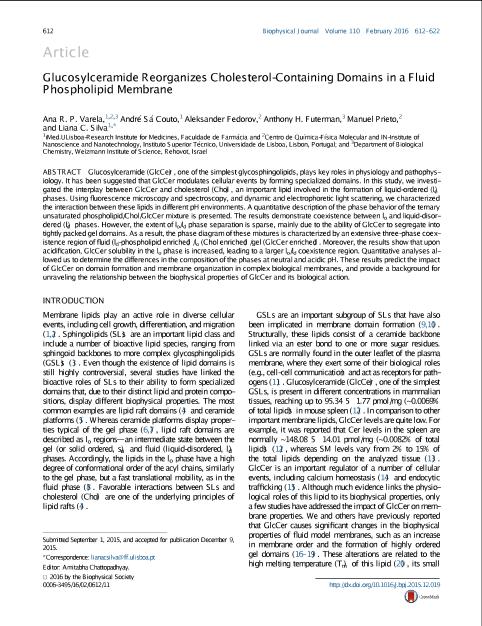
Abstract Glucosylceramide (GlcCer), one of the simplest glycosphingolipids, plays key roles in physiology and pathophysiology. It has been suggested that GlcCer modulates cellular events by forming specialized domains. In this study, we investigated the interplay between GlcCer and cholesterol (Chol), an important lipid involved in the formation of liquid-ordered (lo) phases. Using fluorescence microscopy and spectroscopy, and dynamic and electrophoretic light scattering, we characterized the interaction between these lipids in different pH environments. A quantitative description of the phase behavior of the ternary unsaturated phospholipid/Chol/GlcCer mixture is presented. The results demonstrate coexistence between lo and liquid-disordered (ld) phases. However, the extent of lo/ld phase separation is sparse, mainly due to the ability of GlcCer to segregate into tightly packed gel domains. As a result, the phase diagram of these mixtures is characterized by an extensive three-phase coexistence region of fluid (ld-phospholipid enriched)/lo (Chol enriched)/gel (GlcCer enriched). Moreover, the results show that upon acidification, GlcCer solubility in the lo phase is increased, leading to a larger lo/ld coexistence region. Quantitative analyses allowed us to determine the differences in the composition of the phases at neutral and acidic pH. These results predict the impact of GlcCer on domain formation and membrane organization in complex biological membranes, and provide a background for unraveling the relationship between the biophysical properties of GlcCer and its biological action.

Viscoelastic Properties of Levan-DNA Mixtures Important in Microbial Biofilm Formation as Determined by Micro- and Macrorheology
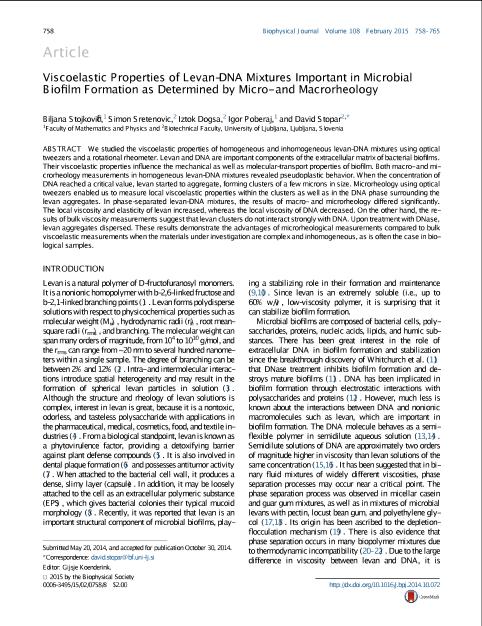
Abstract We studied the viscoelastic properties of homogeneous and inhomogeneous levan-DNA mixtures using optical tweezers and a rotational rheometer. Levan and DNA are important components of the extracellular matrix of bacterial biofilms. Their viscoelastic properties influence the mechanical as well as molecular-transport properties of biofilm. Both macro- and microrheology measurements in homogeneous levan-DNA mixtures revealed pseudoplastic behavior. When the concentration of DNA reached a critical value, levan started to aggregate, forming clusters of a few microns in size. Microrheology using optical tweezers enabled us to measure local viscoelastic properties within the clusters as well as in the DNA phase surrounding the levan aggregates. In phase-separated levan-DNA mixtures, the results of macro- and microrheology differed significantly. The local viscosity and elasticity of levan increased, whereas the local viscosity of DNA decreased. On the other hand, the results of bulk viscosity measurements suggest that levan clusters do not interact strongly with DNA. Upon treatment with DNase, levan aggregates dispersed. These results demonstrate the advantages of microrheological measurements compared to bulk viscoelastic measurements when the materials under investigation are complex and inhomogeneous, as is often the case in biological samples.

{{item.title}}
![]()
{{item.summary}}










